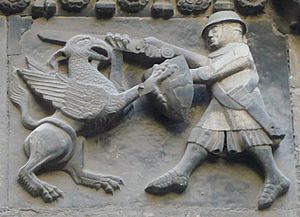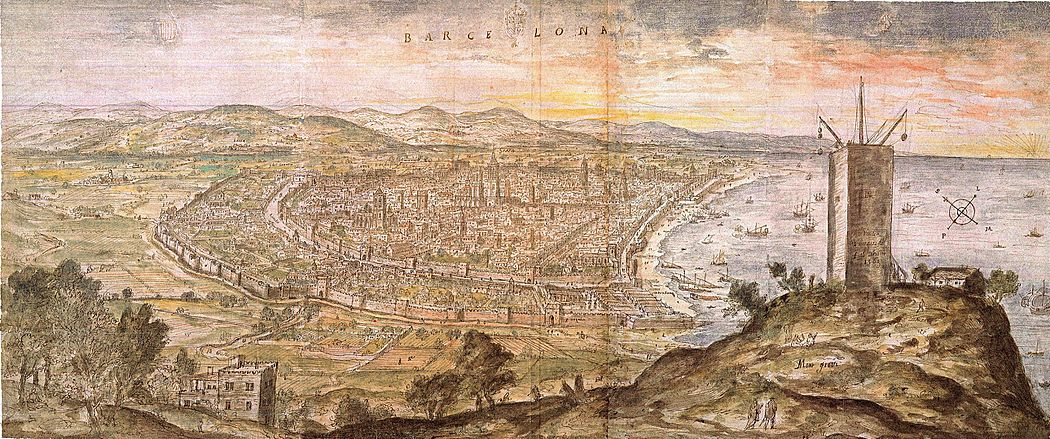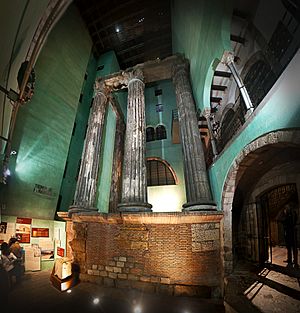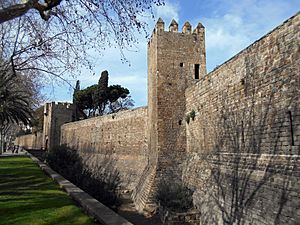History of Barcelona facts for kids

The history of Barcelona goes back over 2,000 years! It started as a small village built by the Iberians called Barkeno. Its location was perfect for defense, nestled between the Collserola mountains and the Mediterranean Sea. This spot was also on a key route between central Europe and the rest of Spain, making it important throughout history.
Today, Barcelona is a big city with over 1.6 million people, making it the second largest in Spain. It's also the capital of Catalonia, a special region in Spain. The wider area around Barcelona is home to a huge part of Catalonia's population.
Contents
How Barcelona Began
It's not totally clear how Barcelona first started. People have found tools and remains from the Stone Age (Neolithic and Chalcolithic periods) near the city. In the El Raval area, archaeologists found old tombs and homes from more than 7,000 years ago!
Later, around 300-200 BC, a group of Iberians called the Laietani lived here. They had a settlement called Barkeno on a hill where the Barri Gòtic (Old City) is today. They even made their own coins! Some historians think a small Greek colony called Kallipolis might have been nearby, but there's no strong proof.
Some stories say that Hamilcar Barca, a general from Carthage (a powerful ancient city), founded Barcelona around 230 BC. He was the father of the famous general Hannibal. He supposedly named it Barkenon. However, most experts agree that the name "Barcelona" likely comes from the old Iberian word Barkeno.
Fun Legends About Barcelona's Start
There are two cool legends about how Barcelona was founded:
- One legend says that the Carthaginian general Hamilcar Barca founded the city around 230 BC.
- Another legend says that the mighty hero Hercules founded the city even before Rome was built! The story goes that Hercules was sailing with Jason and the Argonauts when one of their nine ships got lost in a storm. Hercules found the wrecked ship and its crew safe near a beautiful hill. The crew loved the spot so much they decided to build a city there. They called it Barca Nona, which means "Ninth Ship."
Barcelona as a Roman City: Barcino
The Roman Republic took control of the area around 218 BC. They settled Barcelona and called it Barcino. At first, it wasn't as important as other Roman cities like Tarraco (now Tarragona) or Caesaraugusta (now Saragossa).
Around the year 14 AD, Barcino got its official name: Colonia Faventia Julia Augusta Pia Barcino. It was a "colony" where retired soldiers were given land. Barcino was strategically placed on a Roman road called the Via Augusta, which helped it grow. It also didn't have to pay imperial taxes, which was a big bonus!
The city was built like a Roman army camp, with a central public square (the forum) and main streets crossing each other. The old Iberian settlement on Tàber hill became the heart of Roman Barcino. The city walls were about 1.5 kilometers long, protecting an area of 12 hectares (about 30 acres).
By the 2nd century, Barcino had a population of about 3,500 to 5,000 people. Farming was the main activity, and its wine was sold far and wide. While it didn't have huge public buildings like theaters or circuses, the city seemed quite wealthy. The most impressive building was a temple dedicated to Caesar Augustus, built around the early 1st century. It was quite large for the city's size, with tall Corinthian columns.
Around 250 AD, Germanic tribes started attacking. So, the city's defenses were greatly improved with a new, strong double wall. This made Barcino even more important than Tarraco because it was so well protected.
You can still see many parts of Roman Barcino underground at the Museum of the History of Barcelona (MUHBA).
Early Christians in Barcino
Christian communities began to appear in the region around the 3rd century. The first recorded bishop of Barcino was Prætextatus, who attended a church meeting in 343 AD. Later, Saint Pacian became bishop and wrote important works about Baptism. The first major Christian church in Barcino, the Basílica de la Santa Creu, was built around the late 4th century where the current Barcelona Cathedral stands. You can see its old baptistry at the MUHBA.
Visigoths Take Over: Barchinona
In the early 5th century, the Western Roman Empire was attacked by Germanic tribes like the Goths. The Visigoths, led by Ataulf, moved into Spain and set up their court in Barcino in 415 AD. Ataulf was murdered there.
Later, under Wallia, the Visigoths became allies of the Romans and helped control other tribes. They made their capital in Toulouse (France). Barcino remained an important city for the Visigoths, especially because of its strong defensive walls. After a major battle in 507, the Visigoth capital moved back to Barcino for a while.
The Visigoths were a small part of the city's population, mostly holding positions of power. They were originally Arian Christians, but later adopted Catholic Christianity as the official religion in 589. The city's main church changed from an Arian one to the Catholic Església dels Sants Just i Pastor.
The language spoken was a form of Latin that was changing over time. The name Barcino slowly became Barchinona as the pronunciation evolved.
Jewish Community in Barchinona
A Jewish community lived in Barcino (or Barchinona) from at least the mid-4th century. While the Romans tolerated their religion, Jews faced discrimination and persecution under the Visigoths. Some Visigothic kings made laws against Jewish practices, like their dietary rules and marriage ceremonies.
In 672, King Wamba was elected. He spent most of his rule fighting rebellions. The Jewish people in Barchinona were quite numerous and played a role in one of these revolts, hoping for better treatment. Wamba put down the rebellion and briefly ordered some Jews to leave. However, he was a smart ruler and understood how important the Jewish community was to the economy. Later, another king, Erwig, made new laws against Jews, but they were less harsh than before.
Muslim Rule: Barshiluna
In 711, Muslim forces arrived in Spain. They quickly expanded their territory. After conquering and damaging Tarraco in 717, Barchinona surrendered peacefully. This saved the city from major destruction. Muslim rule in Barshiluna (as they called it) lasted about 85 years.
During this time, the cathedral was turned into a mosque, and non-Muslims had to pay special taxes. However, people were generally allowed to practice their own religion, and local leaders still managed daily life.
Barcelona in the Spanish March
Louis the Pious, son of Charlemagne, captured Barcelona in 801 after a long siege. This was a big win against the Moors. The rivers Llobregat and Cardener became the new borders of the Carolingian empire. These border regions were organized into the Spanish Marches, ruled by counts chosen by the King.
The first Counts of Barcelona were just royal managers, but they slowly gained more power as the Carolingian kings became weaker. By 865, the territory officially became the hereditary County of Barcelona.
Wilfred the Hairy was the last Count of Barcelona appointed by the Carolingian rulers in 878. When he died in 897, his lands were divided among his sons, starting a system where the title was passed down through the family. The Counts of Barcelona became very important because they kept expanding their land by conquering more from the Moors. Barcelona, with its strong defenses, grew and prospered under their rule.
Barcelona Under the Crown of Aragon
In 1162, Alfonso II of Aragon inherited the Crown of Aragon. This happened because Ramon Berenguer IV, Count of Barcelona, had married the future Queen of Aragon, Petronila, in 1137. Even though they were united, the governments of Aragon and Catalonia mostly stayed separate. Barcelona was by far the largest city in Catalonia and a very important source of money for the king.
During this time, Barcelona's economy focused more and more on trade. In 1258, James I of Aragon allowed Barcelona's merchants to create rules for sea trade. In 1266, he let the city appoint special representatives, called "consuls," in major Mediterranean ports.
Barcelona Under the Spanish Monarchy
When Ferdinand II of Aragon and Isabella I of Castile married in 1469, it united the two royal families of Spain. Madrid became the main center of power. The discovery of the Americas also meant that trade in the Mediterranean became less important financially.

The joining of the Spanish kingdoms led to big changes in Europe, including the War of the Spanish Succession (1701-1714). The Catalan nobles supported the Habsburg family against Philip V of Spain. When Philip V won, he took away Catalonia's self-rule with the Nueva Planta decrees in 1716. This reduced Barcelona's political power in Spain.
However, by the late 1700s, Barcelona's location as a port and nearby coal deposits helped it become a key player in the Industrial Revolution. Catalonia, and Barcelona especially, became important industrial centers, growing richer even if they had less political power.
In the 18th century, a fortress was built on Montjuïc hill, overlooking the harbor. In 1794, a French astronomer named Pierre Méchain was allowed to enter the fortress to make important measurements. These measurements helped define the first official metre, which was meant to be one ten-millionth of the distance from the North Pole to the Equator.
In 1812, Napoleon's France took over Barcelona for a few years. In 1888, Barcelona hosted a big event called the Exposición Universal. This led to the city growing a lot, especially with the creation of the Eixample (meaning "the extension") district. Many nearby towns like Sants and Gràcia were absorbed into the city. This prosperity helped Barcelona become a cultural hub again, as seen in the amazing architecture of Antoni Gaudí that you can still see today.
In July 1909, there was a period known as the Tragic Week. The Spanish army clashed with working-class people in Barcelona. When the Prime Minister called up reserve soldiers to fight in Morocco, workers, supported by anarchists and socialists, protested in the streets. Over 100 people died.
Another big international exhibition was held in 1929, which led to more urban development around Plaça Espanya and helped build the metro system, which opened in 1924.
The Spanish Civil War and Barcelona
Barcelona was getting ready to host the People's Olympics in the summer of 1936. They built the Olympic Stadium and developed the Montjuïc area. But in July 1936, a military uprising started the Spanish Civil War. Some athletes who had come for the Games reportedly stayed to join the Republican side.
Barcelona and Catalonia strongly supported the Republican government. Many businesses and public services were taken over by worker unions. As the Republican government's power weakened, anarchist groups controlled much of the city. However, they later lost control to their own allies, the Stalinists and government troops, after street fights known as the Barcelona May Days.
Barcelona was bombed many times from the air. The worst attacks lasted three days, starting on March 16, 1938, during the height of the war. Italian planes, ordered by Benito Mussolini, bombed the city 13 times, dropping bombs on civilians. These attacks were requested by General Franco to punish the Catalan people. More than 1,000 people died, including many children, and over 2,000 were injured. The old Cathedral of Barcelona was also bombed but didn't suffer major damage.
The city finally fell to Franco's Nationalist forces on January 26, 1939.
Barcelona After the War: Francoism
Barcelona's resistance to Franco's takeover had long-lasting effects. After the Republican government was defeated, Catalonia's self-governing institutions were removed. The use of the Catalan language in public life was suppressed, meaning it was discouraged and almost forbidden, though not officially illegal. Despite the war's damage, Barcelona remained Spain's second-largest city and a key industrial and wealthy region.
This led to many people moving to Barcelona from poorer parts of Spain, like Andalucia and Galicia. This caused rapid growth in the city. New districts like Congrés, El Carmel, and Nou Barris were built quickly. Barcelona's surrounding towns also grew dramatically.
The city became very crowded, with many people living in poor conditions. The large number of new residents also meant that the unique Catalan culture of Barcelona slowly declined, as most new arrivals spoke only Spanish. Learning Catalan was not easy, and there wasn't much social pressure to learn it in urban areas. The population boom led to improvements in the metro system, paved streets, traffic lights, and the construction of the first ring roads. Running water, electricity, and street lighting also had to be greatly improved to keep up with the growing population.
Modern Barcelona
When Franco died in 1975, Spain began a period of becoming a democracy again. Barcelona pushed hard for changes because it felt it had been punished for almost 40 years under Franco's rule. On September 11, 1977, over a million people marched peacefully in Barcelona, demanding that Catalonia get its self-rule back. This was granted less than a month later.
Two big events in 1986 helped Barcelona grow even more: Spain joining the European Community and, especially, Barcelona being chosen to host the 1992 Summer Olympics and later the 1992 Summer Paralympics. The city quickly underwent a huge transformation, with new buildings and public spaces. This greatly improved Barcelona's international reputation as a tourist destination. The rising cost of housing caused some families to move to the suburbs in the late 20th century. However, since 2001, a new wave of immigration, especially from Latin America and Morocco, has reversed this trend, and the city's population has grown again.
|
See Also
 In Spanish: Historia de Barcelona para niños
In Spanish: Historia de Barcelona para niños






